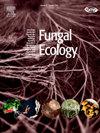致病真菌新生隐球菌与蚂蚁之间的相互作用
IF 2.2
3区 环境科学与生态学
Q3 ECOLOGY
引用次数: 0
摘要
尽管越来越多的环境调查旨在了解真菌病原体新型隐球菌和加蒂隐球菌的生态学,但对它们与节肢动物的关系知之甚少。在本研究中,我们收集了大量来自树木和节肢动物的样本,以确定隐球菌在节肢动物中的发生情况,了解它们是否可以代表环境中扩散的载体,并最终研究它们如何与真菌相互作用。样本来自世界上七个不同的地理区域:意大利西北部、意大利东南部、斯洛文尼亚、科索沃、希腊、土耳其和哥伦比亚。共检测树木1396棵,采集标本11805份,其中节肢动物标本7492份。节肢动物阳性样本主要来自蚂蚁,仅在意大利西北部和东南部、希腊和斯洛文尼亚发现,平均阳性率为0.2%。33棵阳性树有节肢动物阳性,6棵节肢动物阴性。此外,对于6棵树,节肢动物的阳性样本与树木的阳性样本不相关。体外实验表明,蚂蚁可以将隐球菌酵母菌从被污染的基质(土壤或树皮)转移到无菌基质上,并且这种真菌可以在蚂蚁的消化器官内存活。目前的研究表明,尽管蚂蚁与真菌接触的频率很低,但它们是新形梭菌的潜在载体。隐球菌酵母菌可以在蚂蚁体内存活,但它们与宿主的关系是寄生的、共生的还是共生的尚不清楚。本文章由计算机程序翻译,如有差异,请以英文原文为准。

Interactions between the pathogenic fungus Cryptococcus neoformans and ants
Despite the growing number of environmental surveys aimed to understand the ecology of the fungal pathogens Cryptococcus neoformans and Cryptococcus gattii, little is known about their relationships with arthropods. In the present study we collected a large number of samples from trees and arthropods living on them to determine the occurrence of Cryptococcus in arthropods, to understand if they could represent a vehicle for dispersion in the environment, and finally to investigate how they might interact with the fungus. Samples were collected from seven different geographical areas of the world: northwestern Italy, southeastern Italy, Slovenia, Kosovo, Greece, Turkey, and Colombia. A total of 1396 trees were examined and 11,805 samples were collected, including 7492 arthropod samples. Arthropod positive samples, mostly from ants, were found only in northwestern and southeastern Italy, Greece, and Slovenia with an average rate of 0.2%. Thirty-three of positive trees hosted positive arthropods whereas in six of them arthropods resulted negative. In addition, for six trees, positive samples from arthropods were not associated with positive arboreal samples. In vitro experiments showed that ants can transfer cryptococcal yeasts from a contaminated substrate (soil or bark) to a sterile one and that the fungus can survive inside the digestive apparatus of ants. The present study showed that ants are potential vehicles for C. neoformans although the frequency of which they enter in contact with the fungus is low. Cryptococcal yeasts can survive within the bodies of ants, but it remains unclear whether the relationship they establish with their host is parasitic, commensal, or symbiotic.
求助全文
通过发布文献求助,成功后即可免费获取论文全文。
去求助
来源期刊

Fungal Ecology
环境科学-生态学
CiteScore
5.80
自引率
3.40%
发文量
51
审稿时长
3 months
期刊介绍:
Fungal Ecology publishes investigations into all aspects of fungal ecology, including the following (not exclusive): population dynamics; adaptation; evolution; role in ecosystem functioning, nutrient cycling, decomposition, carbon allocation; ecophysiology; intra- and inter-specific mycelial interactions, fungus-plant (pathogens, mycorrhizas, lichens, endophytes), fungus-invertebrate and fungus-microbe interaction; genomics and (evolutionary) genetics; conservation and biodiversity; remote sensing; bioremediation and biodegradation; quantitative and computational aspects - modelling, indicators, complexity, informatics. The usual prerequisites for publication will be originality, clarity, and significance as relevant to a better understanding of the ecology of fungi.
 求助内容:
求助内容: 应助结果提醒方式:
应助结果提醒方式:


